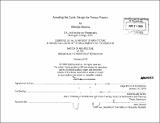Arresting the cycle : design for porous prisons
Author(s)
Abolina, Viktorija
DownloadFull printable version (21.20Mb)
Alternative title
Design for porous prisons
Other Contributors
Massachusetts Institute of Technology. Dept. of Architecture.
Advisor
Adèle Naudé Santos.
Terms of use
Metadata
Show full item recordAbstract
Incarcerating over two million prisoners a year costs the government an astounding twenty-six billion dollars annually, which means the government spends the same amount of money on each inmate as any American would make a year working a minimum wage job. Although cities "generate" the majority of offenders most U.S. prisons are located outside of cities. Every year more than six hundred thousand prisoners are released to return home, but almost fifty percent of the released return back to prison within three years. This migration of offenders back and forth between the cities they live in and rural prisons rendersthese prisons to be a significant part of the urban gestalt. This migration of people from their home communities to rural prisons renders prisons and people they house to be culturally and economically an integral part of urban community. Nevertheless, the money spent on prisons is housed outside of the communities. This thesis does not claim to be a reformation to prison system but, rather, to prison architecture. Through the medium of architectural design, this thesis will attempt to instigate a dialogue questioning the following hypothesis: Spatial and visual interaction with the outside world is necessary for the sustainable reformation of prison inmates. Economic revitalization of the areas with high rates of incarceration can subsequently reduce these rates. Merging these two propositions gives a rise to following key questions: "What are the architectural implications of a prison that is both secure to prevent escape and porous to allow for the infiltration of the community that surrounds it? And, what are the urban implications of an institution that, instead of benefiting corporations, gives back to the community in terms of space and resources?" (cont.) I propose to test the limits of this proposal in an architectural and urban form dismantled over the fabric of New Orleans. This report will describe the background research conducted in order to define an architectural problem for a Master of Architecture thesis and the design solution that came out of this hypothesis.
Description
Thesis (M. Arch.)--Massachusetts Institute of Technology, Dept. of Architecture, 2009. Includes bibliographical references (p. 61-62).
Date issued
2009Department
Massachusetts Institute of Technology. Department of ArchitecturePublisher
Massachusetts Institute of Technology
Keywords
Architecture.